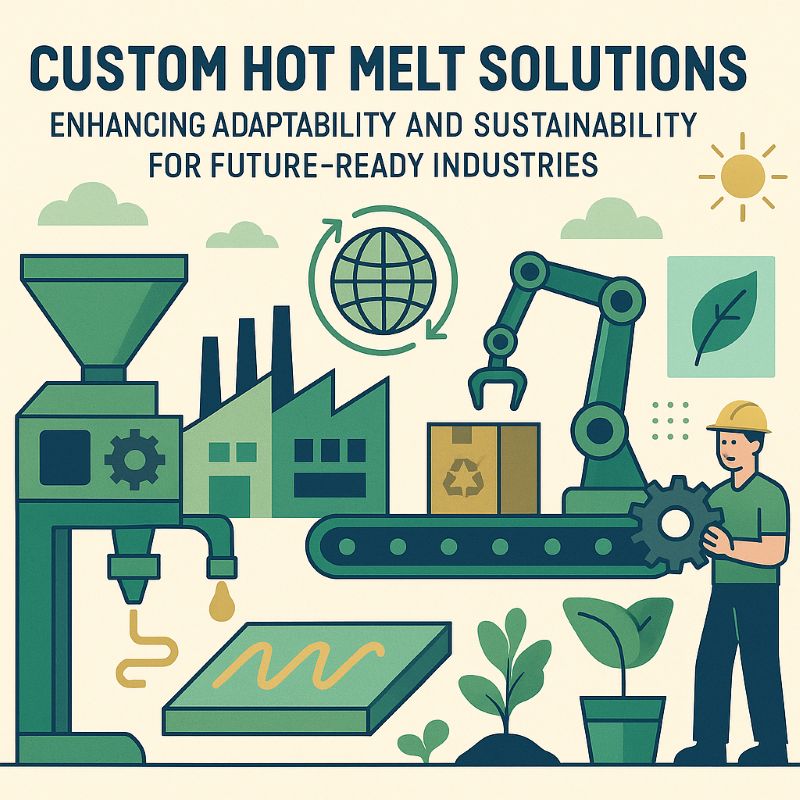
Future-Proofing Defined
Types of Custom Hot Melt Solutions
Importance of Future-Proofing Industries
Methods for Custom Solutions Implementation
Latest Trends in Hot Melt Technologies
Strategic Approaches to Future-Proofing
Case Studies of Successful Applications
In an evolving industrial landscape, future-proofing refers to the proactive preparation of operations, technologies, and products to remain competitive and resilient against future shifts. For hot melt adhesive applications, future-proofing focuses on creating flexible, scalable, and high-performance solutions that adapt to new demands in speed, material compatibility, and environmental compliance. Advanced adhesive systems support industry agility by enabling rapid transitions in manufacturing without sacrificing performance or efficiency.
Custom hot melt adhesives are engineered to match specific operational needs across industries. They vary in viscosity, open time, bond strength, and substrate compatibility. For example, some formulations are optimized for high-throughput packaging, while others are developed for complex material bonding or eco-friendly compliance. Common categories include temperature-resistant adhesives, high-speed formulations, low-VOC variants, and bio-based or recycled-content systems. Each type is designed to align with both present requirements and anticipated future regulations or market trends.
Future-proofing with custom hot melt adhesives is essential for industries facing technological shifts, rising sustainability standards, or changing consumer expectations. Adhesives designed for adaptability can be deployed across multiple production lines, support diverse materials, and integrate with automation systems. As global supply chains evolve and regulatory environments tighten, forward-looking adhesive strategies enable continuous production with fewer disruptions and stronger brand resilience.
Implementing custom adhesive systems begins with a diagnostic approach: understanding application temperature ranges, bonding surfaces, production speed, and environmental conditions. Manufacturers often collaborate with material specialists to conduct pilot tests and optimize dispensing parameters. Adjustments may involve configuring open time for high-speed lines or selecting specific chemistries for difficult-to-bond substrates. An iterative process of testing, feedback, and reconfiguration ensures that the solution remains both effective today and adaptable for future production needs.
Recent developments in hot melt adhesives are centered on three key areas:
Smart adhesive behavior (e.g., self-regulating temperature flow, visual application indicators)
Sustainable formulations (low VOC, bio-based, recyclable)
Precision dispensing (via robotics, slot-die systems, or laser-guided nozzles)
These innovations enable tighter quality control, reduce environmental impact, and open opportunities for broader material compatibility in next-generation manufacturing.
To stay ahead, businesses are embedding hot melt technologies into broader innovation strategies. This includes investing in multi-purpose adhesive systems that work across product lines, aligning adhesive selection with ESG goals, and designing production lines around modular adhesive dispensing units. By treating adhesive integration as a long-term investment rather than a single-use solution, companies enhance their ability to pivot quickly, comply with new regulations, and lead within their market segment.
Across various industries, custom hot melt adhesives have enabled future-ready transitions:
A packaging manufacturer improved uptime and reduced maintenance by adopting a temperature-stable adhesive suited for automated lines.
A high-speed production facility enhanced throughput and reduced waste using a fast-setting, clean-running adhesive.
A furniture producer solved complex bonding challenges involving textured surfaces by switching to a flexible-bonding formula.
A sustainability-focused brand transitioned to a recyclable adhesive formulation, aligning product performance with environmental targets.
These examples illustrate how tailored adhesive technologies can resolve immediate challenges while laying groundwork for sustainable, scalable growth.
What is future-proofing in the context of industries?
Future-proofing involves designing systems and choosing materials that can adapt to future challenges—like regulatory changes, environmental pressures, or shifts in consumer demand—without requiring major overhauls.
What are custom hot melt solutions?
They are adhesive systems developed for specific performance needs, such as bonding speed, substrate compatibility, or environmental compliance. These solutions allow for greater control and long-term flexibility in production.
What are some benefits of using custom hot melt adhesives?
Benefits include increased production efficiency, enhanced bond reliability, compatibility with automation, and support for sustainability goals.
How can industries implement custom hot melt solutions effectively?
By assessing operational conditions, collaborating with technical partners, conducting pilot testing, and fine-tuning parameters to ensure long-term compatibility with production goals.
What are the latest trends in hot melt technologies?
Current trends focus on sustainability, smart behavior (e.g., visual indicators, temperature control), and automation-ready adhesive systems.
Why is sustainability important in hot melt adhesives?
It helps industries meet growing regulatory and consumer demands, reduce emissions, and support circular economy initiatives—without sacrificing bonding performance.
Can you provide examples of successful applications?
Yes. Examples include manufacturers who optimized throughput with high-speed adhesives, solved complex bonding challenges with flexible solutions, or met environmental targets by switching to low-VOC or recyclable adhesive options.